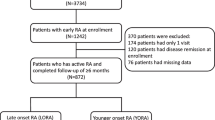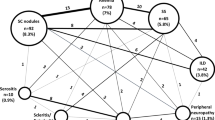Abstract
Background
Rheumatoid arthritis (RA) is a symmetric poly-arthritis predominantly affecting the small synovial joints, although any synovial joint can be involved. The underlying cause is not known; however, predilection for the disease is impacted by genetic and environmental factors. Several factors predict disease severity in RA including development of erosions, female sex and duration of disease. This study evaluates the role of disease duration, early initiation of disease modifying anti-rheumatic drugs (DMARDs) and auto-antibodies like rheumatoid factor in predicting erosive disease in Indian patients with rheumatoid arthritis.
Methods
A 2-year hospital-based cross-sectional observational study was conducted in the Department of Medicine in a tertiary care centre in Kumaon region of Uttarakhand in northern India. 260 patients diagnosed with RA on the basis of 2010 ACR/EULAR criteria were included.
Results
A total of 135 patients had erosive disease, with DMARD naive median period of 3 years compared to 125 patients with non-erosive disease, with DMARD naive median period of 2 years. On the basis of this data and after evaluation for radiographic erosions, it was found that a longer DMARD naive period predicts higher odds of developing erosive disease.
Conclusion
Early diagnosis of rheumatoid arthritis and initiation of DMARDs is crucial in increasing quality of life and preventing severe disease with deformities, erosive changes and extra-articular manifestations.


Similar content being viewed by others
References
Handa, R., Rao, U. R. K., Lewis, J. F. M., Rambhad, G., Shiff, S., & Ghia, G. J. (2016). Literature review of rheumatoid arthritis in India. International Journal of Rheumatic Diseases,19, 440–451.
Malaviya, A. N., Kapoor, S. K., Singh, R. R., Kumar, A., & Pande, I. (1993). Prevalence of rheumatoid arthritis in the adult Indian population. Rheumatology International,13, 131–134.
Pincus, T., Callahan, L. F., Sale, W. G., Brooks, A. L., Payne, L. E., & Vaughn, W. K. (1984). Severe functional declines, work disability, and increased mortality in seventy-five rheumatoid arthritis patients studied over nine years. Arthritis and Rheumatology,27, 864–872.
Lard, L. R., Visser, H., Speyer, I., van der Horst-Bruinsma, I. E., Zwinderman, A. H., Breedveld, F. C., et al. (2001). Early versus delayed treatment in patients with recent-onset rheumatoid arthritis: comparison of 2 cohorts who received different treatment strategies. American Journal of Medicine,111, 446–451.
Van Zeben, D., Hazes, J. M., Zwinderman, A. H., Vandenbroucke, J. P., & Breedveld, F. C. (1993). Factors predicting outcome of rheumatoid arthritis, results of a follow up study. Journal of Rheumatology,20, 1288–1296.
Aletaha, D., Neogi, T., Silman, A. J., et al. (2010). 2010 Rheumatoid arthritis classification criteria: an American College of Rheumatology/European League Against Rheumatism collaborative initiative. Annals of the Rheumatic Diseases,62(9), 1580–1588.
Singer, J. M., & Plotz, C. M. (1956). The latex fixation test. I. Application to the serologic diagnosis of rheumatoid arthritis. The American Journal of Medicine,21, 888–892.
Shankar, S., Grover, R., & Handa, R. (2006). Role of anti cyclic citrullinated peptide antibodies in erosive disease in patients with rheumatoid arthritis. Indian Journal of Medical Research,124, 689–696.
Shankar, S., Handa, R., Aneja, R., Marwaha, V., Ammini, A. C., & Aprajita, V. (2009). Bone mineral density in Indian women with rheumatoid arthritis. Rheumatology International,29, 377–381.
Jacoby, R. K., Jayson, M. I. V., & Cosh, A. (1973). Onset, early stages and prognosis of RA: Clinical study of 100 patients with 11-year follow-up. The BMJ,ii, 96.
Penserga, E. G., Natividad, T. A. L., & Salido, E. S. (2015). Clinical profile of 266 Filipino patients with rheumatoid arthritis included in the rheumatoid arthritis database and registry (RADAR) of the Philippine General Hospital. International Journal of Rheumatic Diseases,18, 433–438. https://doi.org/10.1111/1756-185X.12273.
Zaman, T., Agarwal, S., & Handa, R. (2007). Complementary and alternative medicine use in rheumatoid arthritis: an audit of patients visiting a tertiary care centre. National Medical Journal of India,20(5), 236–239.
Demoruelle, M. K., & Deane, K. D. (2012). Treatment strategies in early rheumatoid arthritis and prevention of rheumatoid arthritis. Current Rheumatology Reports,14(5), 472–480.
Nell, V. P., Machold, K. P., Eberl, G., Stamm, T. A., Uffmann, M., & Smolen, J. S. (2004). Benefit of very early referral and very early therapy with disease-modifying anti-rheumatic drugs in patients with early rheumatoid arthritis. Rheumatology (Oxford),43(7), 906–914.
Author information
Authors and Affiliations
Corresponding author
Ethics declarations
Conflict of interest
Madhav Bahadur, Paramjeet Singh, Vivekanand Satyawali and Arun Joshi declare that they have no conflicts of interest.
Ethical Standard Statement
This article does not contain any studies with human or animal subjects performed by the any of the authors.
Informed Consent
For this type of study informed consent is not required.
Additional information
Publisher's Note
Springer Nature remains neutral with regard to jurisdictional claims in published maps and institutional affiliations.
Rights and permissions
About this article
Cite this article
Bahadur, M., Singh, P., Satyawali, V. et al. Role of DMARD Naïve Period in the Development of Severe Rheumatoid Arthritis. JOIO 54, 513–517 (2020). https://doi.org/10.1007/s43465-020-00077-8
Received:
Accepted:
Published:
Issue Date:
DOI: https://doi.org/10.1007/s43465-020-00077-8




